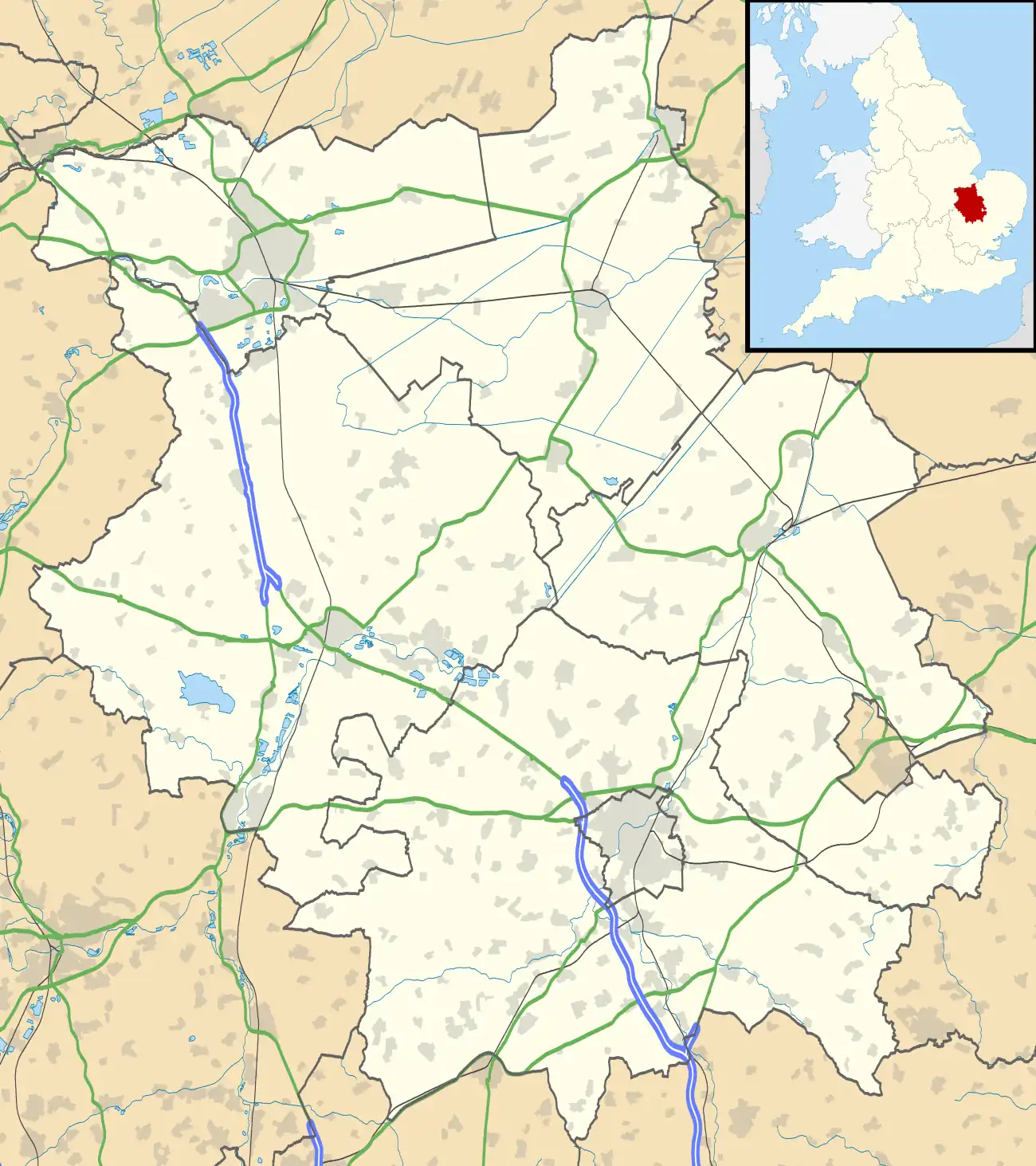| RAF Alconbury USAAF Station 102 | |||||||||||||
|---|---|---|---|---|---|---|---|---|---|---|---|---|---|
| Huntingdon, Cambridgeshire in England | |||||||||||||
 | |||||||||||||
 | |||||||||||||
 RAF Alconbury Shown within Cambridgeshire | |||||||||||||
| Coordinates | 52°21′48″N 000°13′22″W / 52.36333°N 0.22278°W | ||||||||||||
| Type | RAF station (US Visiting Forces) | ||||||||||||
| Code | AY[1] | ||||||||||||
| Area | 497 hectares (1,230 acres)[2] | ||||||||||||
| Site information | |||||||||||||
| Owner | Ministry of Defence | ||||||||||||
| Operator | US Air Force | ||||||||||||
| Controlled by | US Air Forces in Europe – Air Forces Africa previously RAF Bomber Command[1] * No. 2 Group RAF * No. 3 Group RAF | ||||||||||||
| Condition | Operational | ||||||||||||
| Site history | |||||||||||||
| Built | 1937/38 | ||||||||||||
| In use | May 1938–1942 (Royal Air Force) 1942–1945 (US Army Air Forces) 1951 – present (US Air Force) | ||||||||||||
| Battles/wars | European theatre of World War II Cold War | ||||||||||||
| Garrison information | |||||||||||||
| Occupants | 423d Air Base Group | ||||||||||||
| Airfield information | |||||||||||||
| Identifiers | IATA: AYH, ICAO: EGWZ, WMO: 035620 | ||||||||||||
| Elevation | 50 metres (164 ft)[1] AMSL | ||||||||||||
| |||||||||||||
| Notes: Flying ceased in 1995 | |||||||||||||
Royal Air Force Alconbury, or more simply RAF Alconbury, is an active Royal Air Force station near Huntingdon, England. The airfield is in the civil parish of The Stukeleys, close to the villages of Great Stukeley, Little Stukeley, and Alconbury. Flying operations are no longer based at the site, with most of the land, including the runway, having been sold in 2009 to become the new settlement of Alconbury Weald.
History
Opened in 1938 for use by RAF Bomber Command, the station has been used from 1942 by the United States Army Air Force.[3] It was occupied by the 93d Bomb Group of the Eighth Air Force: visitors included King George VI who visited the site and saw the Boeing B-17 Flying Fortresses there on 13 November 1942.[3]
It was announced by The Pentagon on 8 January 2015 that RAF Alconbury and RAF Molesworth would be closing by 2020. Most of the units at Alconbury and Molesworth were to be moved to RAF Croughton, along with the personnel.[4] The decision was later reverted on the grounds of cost-effectiveness, with RAF Alconbury remaining as a support base for the Joint Analysis Center.[5]
Royal Air Force use
- 15 Squadron from 15 April 1940 to 15 May 1940 operating the Bristol Blenheim IV - temporary move from RAF Wyton.[6]
- 40 Squadron from 2 February 1941 to 31 October 1941 operating the Vickers Wellington IC - moved to RAF Luqa, Malta.[7]
- 52 Squadron detachments from RAF Upwood during 1939 with the Fairey Battle and Avro Anson.[8]
- 156 Squadron formed at Alconbury on 14 February 1942 from elements of 40 Squadron with the Vickers Wellington, moved to RAF Warboys in August 1942.[9]
- A Detachment from No. 1 Photographic Reconnaissance Unit RAF (April 1985)[10]
- No. 3 Photographic Reconnaissance Unit RAF (1941)[11]
- No. XV Conversion Flight (January 1942 - May 1942)[12]
- Sub site of No. 264 Maintenance Unit RAF (November 1945 - September 1948)[13]
USAAF use
- 92nd Bombardment Group (Heavy)[14]
- 93rd Bombardment Group (Heavy)[14]
- 95th Bombardment Group (Heavy)[15]
- 482nd Bombardment Group (Provisional)[14]
- 801st Bombardment Group (Provisional)[16]
United States Air Force use
Based units
Units based at RAF Alconbury.[17]
- United States Air Force
United States Air Forces in Europe - Air Forces Africa (USAFE-AFAFRICA)
- 501st Combat Support Wing
- Headquarters 501st Combat Support Wing
- 423rd Air Base Group
- 423rd Civil Engineer Squadron
- 423rd Communications Squadron
- 423rd Force Support Squadron
- 423rd Medical Squadron
- 423rd Security Forces Squadron
See also
References
Citations
- 1 2 3 Falconer 2012, p. 33.
- ↑ "Defence Estates Development Plan 2009 – Annex A". GOV.UK. Ministry of Defence. 3 July 2009. p. 15. Retrieved 4 May 2019.
- 1 2 "Alconbury". American Air Museum in Britain. Retrieved 26 November 2021.
- ↑ "RAF Mildenhall to close amid other Europe consolidations". Stars and Stripes.
- ↑ "RAF Alconbury to remain as a Base for the US Visiting Forces". 501st Combat Support Wing. 22 March 2021. Retrieved 28 July 2023.
- ↑ Jefford 1988, p. 29.
- ↑ Jefford 1988, p. 38.
- ↑ Jefford 1988, p. 41.
- ↑ Jefford 1988, p. 63.
- ↑ Sturtivant, Hamlin & Halley 1997, p. 49.
- ↑ Sturtivant, Hamlin & Halley 1997, p. 50.
- ↑ Sturtivant, Hamlin & Halley 1997, p. 96.
- ↑ Sturtivant, Hamlin & Halley 1997, p. 216.
- 1 2 3 4 5 6 7 8 9 10 11 12 13 14 15 16 17 "Alconbury". Airfields of Britain Conservation Trust. Retrieved 2 May 2022.
- 1 2 3 4 5 "95th Bombardment Group (Heavy)". Mighty 8th Cross-Reference - Preller. Retrieved 2 May 2022.
- 1 2 3 4 5 "801st Bombardment Group (Provisional)". Mighty 8th Cross-Reference - Preller. Retrieved 2 May 2022.
- ↑ "Units". 501st Combat Support Wing. Retrieved 13 February 2019.
Bibliography
- Falconer, J (2012). RAF Airfields of World War 2. UK: Ian Allan Publishing. ISBN 978-1-85780-349-5.
- Jefford, C.G. (1988). RAF Squadrons. A comprehensive record of the movement and equipment of all RAF squadrons and their antecedents since 1912. Shrewsbury: Airlife. ISBN 1-85310-053-6.
- Sturtivant, R; Hamlin, J; Halley, J (1997). Royal Air Force flying training and support units. UK: Air-Britain (Historians). ISBN 0-85130-252-1.
